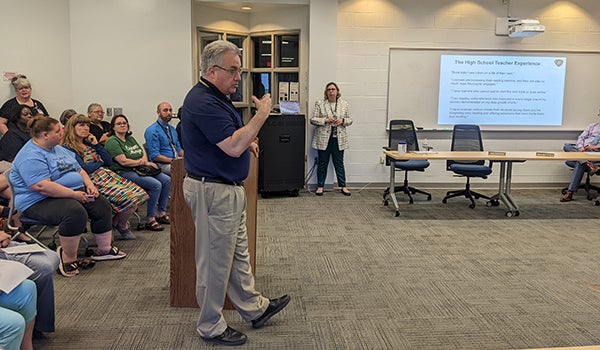Niles Community Schools talks classroom libraries, book-vetting process
Published 6:51 pm Wednesday, May 18, 2022
|
Getting your Trinity Audio player ready...
|
NILES — Niles Community Schools presented the board of education with an update on the state of its classroom libraries during Monday’s meeting at Niles Cedar Lane.
As school libraries have become a hot-button issue across the country, Niles Community Schools administrators provided those in attendance with both the district’s literacy model as well as its book acquisition and vetting process.
Bingham impressed upon the board the positive impact classroom libraries have had on literacy in the district.
According to NCS curriculum director Ann Bingham, the district defines literacy as “the ability to identify, understand, interpret, create, communicate and compute using multiple medias associated with varying contexts. Literacy involves a continuum of learning to enable an individual to achieve his or her goals, to develop his or her knowledge and potential, and to fully participate in the wider society.”
The NCS Secondary Literacy Model has three components:
- Independent Reading — Students access Michigan academic standards for English Language Arts via a self-selected text.
- Book Clubs — Teachers provide multiple options to engage in a variety of texts with a group of their peers.
- Anchor Texts — All students read from the same text that is selected by the teacher.
Former English teacher and current assistant principal Chris Porter noted that he has seen the difference both the literacy model and classroom libraries have made in the lives of students.
“Around lunchtime, kids still have their phones, they’re on the phone,” he said. “But I have kids carrying on books now, and that’s just like one kid at the table, several kids have books. If I see a book, I recognize I can have a conversation about it with them and know they’ve actually read it because they can have that conversation. I wouldn’t have said that was a reality two years ago, because it wasn’t, so just seeing that has been really powerful for me.”
Shannon Lamberton, a seventh-eighth grade teacher at Eastside Connections School, spoke about the importance of finding ways to encourage students to read and how the classroom libraries play a role in that process.
“It is vital that we have a classroom library that can accommodate the different interests of 80 to 100 students year after year,” she said. “Just like the students we serve change every year, so do their interests. As a language arts teacher, it’s our job to get to know our students and in a way that allows us to learn these interests so that we can help them find that one book that’s going to change their outlook on reading.”
The student experience
Niles New Tech Director Jerry Holtgren presented the board with survey data polling high school students regarding their experience with classroom libraries. He shared several slides of survey results with the board, including that 97 percent of 183 students surveyed said they enjoy reading more when they select their own books, and 79 percent of 110 students said they have read a book while in high school that helped them in some way or had an impact on them.
“I get emotional about this because our kids are connecting to reading and that is the goal,” Holtgren said. “We’re preparing them for something great, or so I feel like we’re really reaching our goals.”
Loading the libraries
Dr. Bingham closed the presentation by discussing the district’s book selection and vetting process. During the 2021-22 school year, the curriculum department and 6th through 12th grade English Language Arts teachers reviewed classroom library books based on concerns shared by parents.
Upon reviewing the classroom books, the ELA teachers discussed and reflected on their process for classroom library selection. Acknowledging different opinions, taking into consideration grade/age level recommendations made by publishers and book distributing sites and teacher discretion were key components to the reviewing and vetting process. Bingham acknowledged that controversial books may require additional vetting (e.g., colleague review, reading of the text, online parent and teacher guides and reviews, etc.) and that additional discretion with the books may be required, including parent permission.
Bingham stressed the importance of parent involvement in the book selection process. ELA teachers reviewed the processes in which parents can engage the school regarding books, including access to their child’s progress, perception and book selection as well as email communication and parent-teacher conferences. In addition to the parent communication by ELA teachers at the beginning of the year, a classroom library book list will be made available to parents.
Going forward, teachers will use websites such as Amazon, Barnes & Noble and teachingbooks.net to verify grade-level appropriateness of books. Parents, students, teachers and administrators will have digital access to the district’s independent reading parent letter, all classroom library titles and to the text reconsideration form next year.
“This is an excellent tool that we didn’t feel was transparent and readily accessible that we want to make sure more stakeholders had access to,” Bingham said. “I’d like to reiterate that the district stands by our teachers as experts with the best understanding of the diverse literary needs and developmental items levels of our middle school and high school.”
During the public comment session that followed the presentation, concerned parents voiced their concerns about the district’s library content and its vetting process.
“Those books have been there for a year now but the information is just now coming to the parents,” said one parent during public comment. “It is important because the stakeholders are the principals, the teachers, the parents, students and not to mention the public at large and the school board is responsible for making sure progress is made, achieving the gaps that need to be closed and making sure the public is informed.
“My son is in the seventh grade,” the parent continued. “I want you to imagine that he brought a book home and how you would feel about him reading that without your permission. It’s almost like if your child is at someone’s house and they’ve watched a movie, and afterwards they say, ‘sorry, we didn’t ask for your permission. I guess we’ll pull it from our list.”







